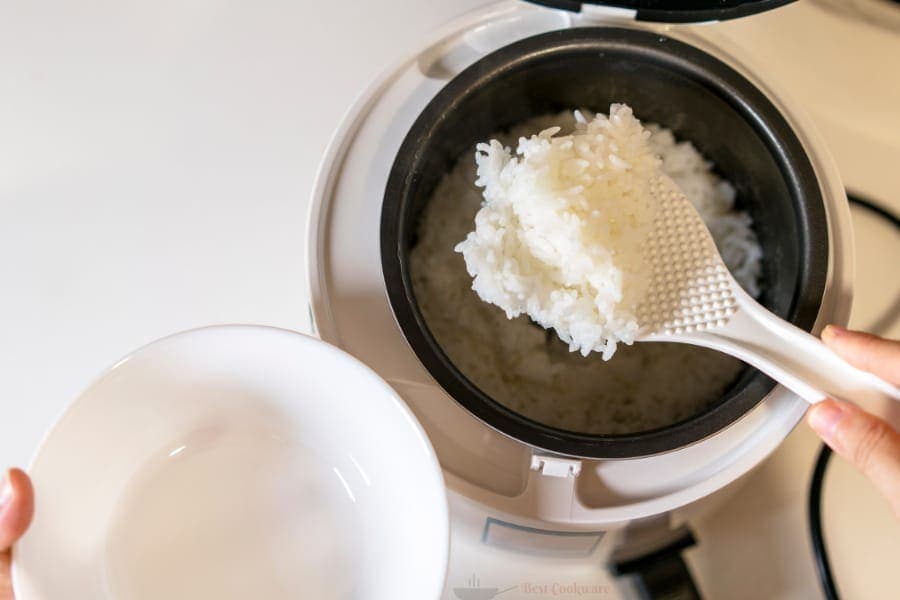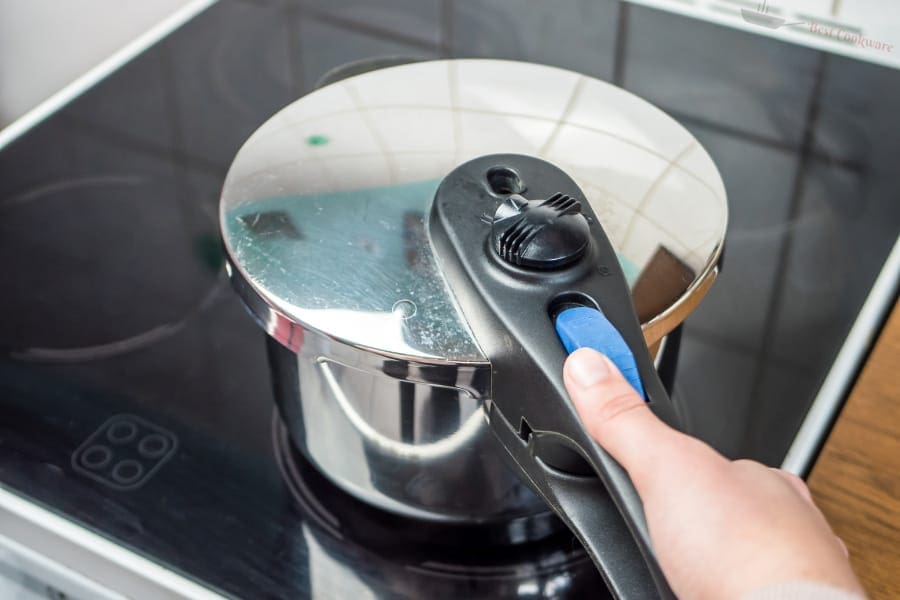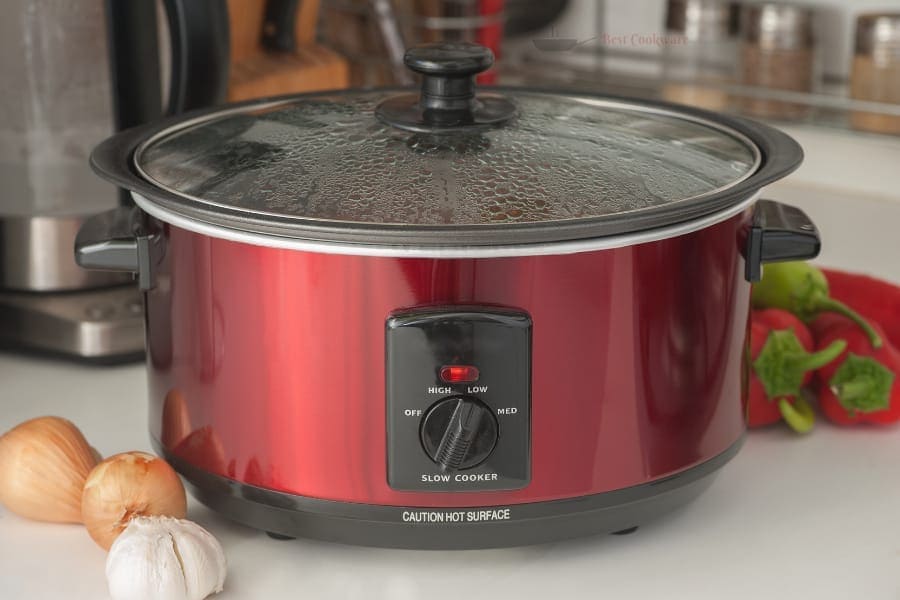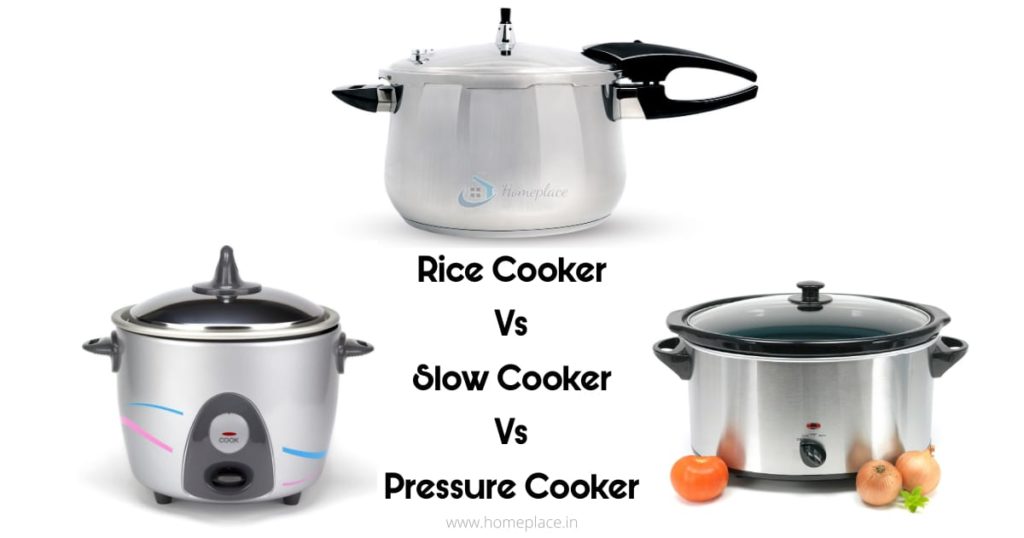Rice cooker, pressure cooker, and slow cooker make cooking easier and serve food on the table within minutes.
Now, the question is: which would you prefer to add to your kitchen?
You may have heard of each appliance when you want honest recommendations among Rice Cooker vs. Pressure Cooker vs. Slow Cooker. Thus picking up the most suitable cooker has become a bewildering task for you. Take an insight into this guide and know the unique features of rice, pressure, and slow cooker to enhance your cooking efficiency.
What is a rice cooker?
As the name implies, rice cookers are excellent cooking appliances for making steamed rice. If you face trouble cooking perfectly flavored rice grains, a rice cooker will be your one-stop solution. It helps cook whole grains like oatmeal, quinoa, millet, and everyday breakfast cereals.
If you want to cook rice or other grains more quickly, this automated rice cooker would be of your help. The best rice cookers in India are energy-efficient, user-friendly, and designed to cook rice for everyday needs.
As long as people consider rice a staple diet, multifunctional rice cookers are evident. This kitchen appliance has gone through so much transformation and become more innovative than ever with passing years. Take a look at the multiple benefits and limitations of incorporating rice cookers in your kitchen.

The advantages of rice cooker
Disadvantages of rice cooker
Best uses of rice cookers
Buying a rice cooker will be a good decision for people who find it hard to cook rice perfectly without assistance. If you’re habituated to cooking plenty of rice every day for your family, getting a rice cooker can be helpful for the long run.
Make your cooking of rice, barley, polenta, quinoa, millet, oatmeal, and other steaming completely hassle-free, and get ready for a delicious serving.
The best part of using this kitchen appliance is that it helps your rice keep warm for hours. Thus, there’s no need to heat it repeatedly whenever you eat. Moreover, you can spend extra quality time with your family as the rice cooker prevents you from checking the rice during preparation.
Editor’s recommendation for rice cooker
Prestige PRWO 1.8-2 700-Watts Delight Electric Rice Cooker has a capacity of 1.8 liters with two cooking pans. It requires 700 watts of power to cook up to 1 Kg of rice at a time. Having cool-touch handles and keep-warm mode, it is a safe choice for everyone.
- Content: Prestige Delight Electric Rice Cooker (1.8 Open Type with Aluminium Cooking Pan-2U)
- Net Quantity: 1 Unit.Voltage : 230 V
- Voltage: 230V; Wattage: 700W
- Warranty: 1 Year
- Troubleshooting guidelines: Do not wash the main body of cooker or immerse it in water. Its electrical insulation may get damaged. Read user...
What is a pressure cooker?
A pressure cooker is sealed cookware that can boil grains and other food items in high-pressure steam. When the cooking process is over, the inner pressure is reduced to the outside atmospheric pressure to open the vessel conveniently.
There’s no denying that pressure cookers are one of the most common cooking utensils in every kitchen. As per ideal gas law (PV=nRT), the temperature of fluids increases with the rise in pressure while the volume is kept constant. In a pressure cooker, the volume is fixed by its capacity, and the pressure rises as long as water evaporates and turns to steam. This increases the boiling point of water to 121°C (instead of 100°C) and helps the food cook faster.
For a hassle-free daily cooking experience, there’s no better option than pressure cookers. In case you are in a hurry and want to cook your food items or grains within a brief time while maintaining their flavors, a pressure cooker will be ideal for you. The best pressure cookers in India are durable, easy to use, and efficient for cooking.
There’s no substitute for pressure cookers for making your everyday meal cooking super-fast. From preparing beans, rice, lentils, pasta to single-meal like vegetable stew, braised chicken – you can reduce your cooking time to half than the usual.

Types of pressure cookers
Available in both stovetop and electric models, these are multifunctional cookers. Under stovetop models, the two commonly available cookers are stainless steel pressure cooker and aluminum pressure cooker. While aluminum pressure cookers cook food faster, stainless steel pressure cookers are more durable and long-lasting. Compare stainless steel and aluminum pressure cookers to learn more about them.
The modern-day electric pressure cooker will be your best solution if you want effortless cooking. You just need to plug the device into an electrical plug, and the food will get ready simply with the help of customized cooking menus.
Also Read: Pressure Cooker vs Pan
Benefits of using a pressure cooker
Limitations of pressure cookers
Best uses of pressure cookers
After putting the food along with the right amount of water, seal the lid and adjust with the valve so that no moisture can come out. Once the steam starts building, the increasing pressure and temperature will prepare the food.
You can try out different yummy dishes like dried beans, grains, hard-boiled egg, curry, soup, risotto, porridge, mashed potato, vegetables, chicken broth, cheesecake, and many other food items to prevent the lengthy time of food making.
Editor’s recommendation for pressure cooker
Hawkins Contura hard-anodized aluminum pressure cooker comes with various capacities of 1.5, 2, 3, 3.5, 4, 5, 6.5 liters. Having a base with 3.25 mm thickness, it is pretty durable and long-lasting. If you are looking for a good quality pressure cooker, it can be an excellent choice.
- Ideal for 3 or 4 Persons
- Hard Anodised body and Stainless Steel lid
- Black body heats faster
- Does not react with food
- Inside-fitting safety lid − will not open until pressure falls
What is a slow cooker?
The slow cooker cooks food items at a lower temperature and takes more cooking time than usual. Slow cookers function entirely in the opposite principle of pressure cookers.
They have a heating element installed at the bottom, and when electricity is applied, it slowly heats up the container and the food. Slow cookers also come with lids that help lock the moisture inside the pot. These lids are made of metal (mostly stainless steel), glass, or ceramic.
You can understand from its name that a slow cooker allows cooking food in a simmer setting. Thus, the low heating and slow process can make your food even unattended for a long time.
If you want power-saving cookware, the slow cooker is your best option! From 1970 till now, slow cookers have gone through many transformations. You can now choose from a wide range of available options like programmable, portable, and even manual slow cookers for regular use.

Advantages of slow cooker
Drawbacks of slow cookers
Editor’s recommendation for slow cooker
Bergner Elite Stainless Steel Electric Slow Cooker has a large capacity of 2.5 liters and runs only on 160 watts of power. You can adjust the heat generation with three modes- low, high and warm suitable for any particular recipe.
- Ideal for 3 or 4 Persons
- Hard Anodised body and Stainless Steel lid
- Black body heats faster
- Does not react with food
- Inside-fitting safety lid − will not open until pressure falls

Comparison of Rice Cooker vs. Pressure cooker vs. Slow cooker
| Point Of Difference | Rice Cooker | Pressure Cooker | Slow Cooker |
|---|---|---|---|
| Energy Source | Electricity | LPG/PNG or electricity | Electricity |
| Application | Rice cookers are used for cooking rice faster than the traditional method with handi. | Pressure cookers are used for cooking food items (meat, rice, vegetable) faster. | Slow cookers are used for slow cooking recipes like stew, soup, etc. |
| Safety | Rice cookers are safe to use with automatic shut-off. | Pressure cookers are safe to cook on a pressure cooker, but users should take care from steam. | Slow cookers are the safest appliance to use as they do not produce superheated steam. |
| Cleaning and Maintenance | Easy to clean and maintain. | Takes more effort to clean compared to rice cookers. | It is also easy to clean and maintain. |
| Cost | Rice cookers are costlier than pressure cookers and cheaper than most slow cookers.(Price Range: ₹700-₹4000) | Stainless steel pressure cookers are the cheapest kitchen appliances compared to rice and slow cookers. But electric pressure cookers are the costliest. (Price Range: ₹300-₹8000) | Slow cookers are costlier than both pressure cookers and rice cookers. (Price Range: ₹2000-₹8000) |
| Ease of Use | It is the most easy-to-use cooker compared to others. | It is convenient to use while you are in a hurry. | Slow cookers are easier to use than pressure cookers. |
| Power Requirement | Rice cookers consume moderate electricity in the range of 500w to 800w. | Metallic pressure cookers do not need electricity to run. However, the electric pressure cooker consumes the highest electricity (more than 1000w) compared to the rice cooker and slow cooker. | The power consumption rate of slow cookers is the lowest (100w-400w). |
Differences of Rice Cooker, Slow Cooker and Pressure Cooker
Rice, slow, and pressure cooker have some crucial differences based on their working methods, application, maintenance, price, convenience, safety, power requirement, etc. You should be aware of them before selecting the ideal cooker for your kitchen.
1. operational Differences
Different stages through which the rice gets cooked are- rinsing in water, boiling, steaming, and warming up. In rice cookers, the heating element transfers the heat to the cooking pan for warming up the rice and water. The cooking pan transfers the heat faster because of highly conductive metals such as copper or aluminum.
A pressure cooker works slightly differently than a rice cooker. It comes with a safety valve that keeps the internal pressure in check. As soon as the cooker’s temperature goes up, superheated steam is produced by the inside liquid, and it gradually increases the pressure. It stimulates the fast cooking of the food. The fluid and moisture are also absorbed into the food rapidly, which expedites the cooking process and makes solid food items like meat softer.
Slow cookers are a very convenient device for cooking meals in an automatically set timer, where the time required for cooking the meal ranges from 2 hours to 8 hours. The lid of the slow cookers is used to cover the pot and seal it, which promotes even distribution of heat. With programmable slow cookers, you can set the temperature at high or low, set a timer for cooking, and get your meal ready accordingly. This is why slow cookers are better for making one-pot meals than pressure cookers or rice cookers.
2. Different Applications
As the name suggests, rice cookers are made to cook rice more hassle-free than traditional methods. Beyond what the name suggests, rice cookers are also used to prepare hot cereals, cooking vegetables, chicken breast, fish fillets, and even shrimp. Rice cookers can also be used for steaming purposes. You can also use a rice cooker efficiently for making stews, soups, or beans by adding a sufficient quantity of water and the required spices and ingredients.
Pressure cookers are perfect for fast cooking. The multiple purposes that a pressure cooker serves include boiling food, braising them, and even simmering it. Some of the dishes that can be conveniently cooked using pressure cookers include stews and soups. You can also use a pressure cooker to boil vegetables like carrots, beans, and beetroots. The best electric pressure cookers in India come with an automated option for cooking various dishes.
Although we generally use a slow cooker for cooking rice or one-pot meals, there are many other purposes that a slow cooker serves, which include boiling, baking, and even frying. Thus, slow cookers can also be used to make stews and soups, but their applications are limited compared to a pressure cooker.
3. Which cooker is safest to use?
Rice cookers are electric kitchen appliances for which the manufacturers include automatic cut-off systems. To use the rice cookers safely, read the user manual and follow the instructions given. The area where you are using the rice cooker must be free from any hindrance.
Pressure cookers are among the most convenient kitchen appliances, but you should be careful when using them. The non-electric pressure cookers have stainless steel or aluminum bodies that heat up when cooking. So, be cautious and do not touch it with bare hands. On the other hand, electric pressure cookers are safer to use, like rice cookers.
Slow cookers are safe to use and can be left unattended for a couple of hours. However, one must make sure that they have set the correct temperature timer and filled up the required ingredients to cook properly.
4. Cleaning and Maintenance requirements
Firstly, following the instructions given in the user manual is essential for the daily cleaning of a rice cooker. Make sure to turn off the power and unplug it before the process. Then use a wet cloth soaked with soap solution to clean the rice cooker body. Clean the interiors after every use. You can wash the cooking pot like any other cookware.
For proper cleaning of the pressure cooker, detach all the parts of the pressure cooker: the lid, gasket, pot, and valve, and then wash them thoroughly with a detergent. But remember not to use any harsh chemicals on the gasket.
If the food is stuck on the pressure cooker’s base, you can soak it with warm water and then wash it with a dishwasher detergent. Finally, completely dry the different parts of the pressure cooker before reassembling it. Pressure cookers need more maintenance compared to rice cookers or slow cookers.
Before cleaning a slow cooker, make sure to unplug the slow cooker and remove the inner bowl. It can be washed with soap water or dishwasher detergent. The exterior of the slow cooker must be cleaned with a damp cloth with the soap solution. Drying the interior bowl before attaching it to the body is recommended.
5. pressure cooker vs. rice cooker vs. slow cooker: Cost
Rice Cooker: The cost of a rice cooker ranges from a minimum of ₹700 to over ₹4000.
Pressure Cooker: The cost of a pressure cooker ranges from a minimum of ₹300 to ₹8000.
Slow Cooker: The cost of a slow cooker is around ₹2000 to ₹8000.
Therefore, if you are looking for a budget-friendly cooker, choose a pressure cooker made of stainless steel. Otherwise, rice cookers are good options as slow cookers are the costliest in the Indian market.
6. Ease Of Use
A rice cooker is straightforward to understand and use. Although rice cookers have several variations, the cooking procedure is similar. Following the instructions in the manual will help you have a mess-free cooking experience.
Pressure cookers are easy to use but not as easy as rice cookers or slow cookers. However, with just a little attention, you will be able to cook any dish super quickly and without any difficulties.
Slow cookers promote one of the most convenient forms of cooking as you can adjust the temperature and timer and then sit back and relax until the food is cooked. Unlike a rice cooker or pressure cooker, using a slow cooker is super easy and does not require your constant attention.
7. Power Requirement
Rice Cooker: In general, a 1.8L rice cooker requires 550 watts of power for cooking. The average range is 500-800 watts.
Pressure Cooker: The stainless steel pressure cookers are not powered by electricity. However, a 3L electric pressure cooker consumes an average of 1000 watts of energy.
Slow Cooker: Slow cooker use a little electricity to run. A typical 3.5L slow cooker consumes around 200 watts of power. The average power usage is around 100-400 watts.
Therefore, we can conclude that pressure cookers made of stainless steel are most preferable as they do not need electricity to run. Slow cookers are also a reasonable option with low power consumption in terms of power requirement.
So, Pressure Cooker, Rice Cooker, or Slow Cooker – Which is Better for You?
Now, the most confusing thing that comes to your mind is choosing between Rice Cooker Vs. Pressure Cooker vs. Slow cooker. Well, to make your task easier, here’s the solution.
Pressure cookers are the most suitable option compared to rice cookers or slow cookers. This is because they have the most versatile uses- what you can cook in a pressure cooker can also be cooked in the rice cooker or slow cooker. On the other hand, rice cookers specialize more in cooking rice, and slow cookers are perfect for making stews.
Look into your food habits, cooking time, convenience, kitchen space, flexibility, and other vital factors that can help you get an exceptional meal every time you want. When you initiate making your daily rice preparation in a rice cooker, the slow cooker will help you get your perfect side dish done. So, choose the ideal cooker wisely and make your kitchen time fully functional.
Related Post:
- Inner Lid Vs Outer Lid Pressure Cooker
- Rice Cooker vs Instant Pot
- Electric Pressure Cooker Vs Multicooker
Last update on 2024-04-18 / Affiliate links / Images from Amazon Product Advertising API


